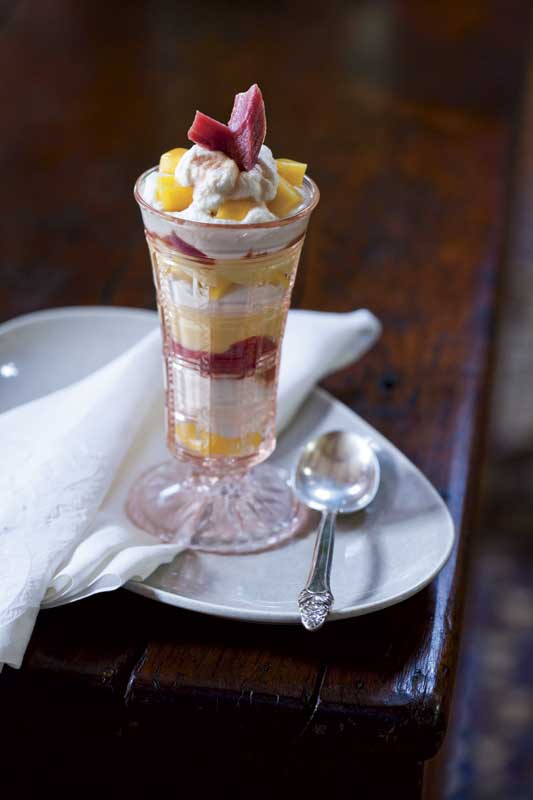Recipe for Entertaining
Stepping across the threshold of Lisa Ekus-Saffer’s 18th-century farmhouse in Hatfield, Massachusetts–past the long table, carefully set from her vast collection of plates, glassware, and candles–you instantly know that you’re welcome and that a great meal awaits. “When my first husband and I bought this house in 1983, it was a disaster,” Lisa says, flashing […]

Rhubarb-and-Mango Compote
Photo Credit : Keller + KellerStepping across the threshold of Lisa Ekus-Saffer’s 18th-century farmhouse in Hatfield, Massachusetts–past the long table, carefully set from her vast collection of plates, glassware, and candles–you instantly know that you’re welcome and that a great meal awaits. “When my first husband and I bought this house in 1983, it was a disaster,” Lisa says, flashing a Cheshire Cat grin. “It was a total labor of love. The house had to be completely restored, and we did it with respect for its original integrity. But it had to have an end result: integrating our life with our work.” Her work is a multilayered media agency, The Lisa Ekus Group, specializing in promoting cookbooks and chefs, as well as training authors, product spokespeople, and restaurant cooks for media appearances.
“I started in publicity at Random House, working with food and chef titles,” Lisa says. “I immediately knew how to create a story around what the authors were doing with food through their cookbooks. We launched Emeril [Lagasse], who had never done television, and, fortunately, the publisher understood that we needed [to provide] integrated media training before sending him on a national tour.”
Preparing chefs and food writers for the pressure of cooking and talking about food in front of live audiences is still a big part of what Lisa does–thus the design of her kitchen. The large space is all about flow, efficiency, and being comfortable–“designed within an inch of its life,” she notes. The front, flanked by a wall of windows, is the prep area, with a custom sink and a skylight to bring in natural light–perfect for seeing ingredients clearly, and for filming (and entertaining). In the middle, she installed two gas ovens, six high-performance butane burners, a griddle, and a built-in Chinese wok. “While you’re cooking, whatever you need is in that space,” Lisa explains. “If you go to reach for a whisk, a spatula, a spoon, or tongs, it’s there,” as are all manner of spices and measuring tools. The final section holds plenty of counter space and storage–including six pull-out wooden cutting boards, doubling the work area–plus all her plates and cutlery and a second sink for cleanup.
Although her home is designed for professional chefs, it’s also a place to cook with family and friends. On this spring day, Lisa has set the table for her husband, David Saffer; daughter Sally Ekus, also a Lisa Ekus Group staffer; chef Deb Snow, co-owner of the acclaimed Blue Heron Restaurant in nearby Sunderland; and longtime friend (and new neighbor) Sandy D’Amato, owner of Sanford Restaurant in Milwaukee, Wisconsin.
The meal begins in the library, a two-level room surrounded by an elegant yet strong framework of cherrywood shelves holding some 11,000 books (7,000 of which are food-related). Around the room (and throughout the home) are extraordinary artwork, antiques, and ephemera from local shops and tag sales as well as mementos from travels all over the globe.
In the kitchen, Deb is slicing and plating succulent lamb chops to serve with a garlicky potato-based dip, while Sandy knows his elegant Russel Wright demitasse cups from the 1940s will wow Lisa; they’ll be just the thing for serving his asparagus soup. Soon the group is all together in the library, joined by Deb’s partner, Barbara White; Sandy’s wife, Angie; and Sally’s beau, Kyle Borut–all discussing cookbooks and food. Sandy and Angie are going over their plans for a culinary center at their new home; they’ve already begun planting a fruit orchard with plum, apple, pear, cherry, peach, and apricot trees. Deb and Barbara respond to a question about the pleasures and difficulties of running a sustainable-food business. “It wasn’t a hard choice, but sometimes the process isn’t as easy as with conventional restaurants,” Deb explains. “Once we got set up, though, we’ve found recycling rewarding–not just the glass, plastic, and paper, but our vegetable waste goes back to farms for animal feed, and our frying oil gets reused as auto fuel.”
When it’s time for the sitdown, David makes certain everyone has something in his or her glass, while Deb, Sandy, and Lisa plate the meal. Soon the big table is jumping with lively conversation–Lisa’s recipe for entertaining proves delicious.


